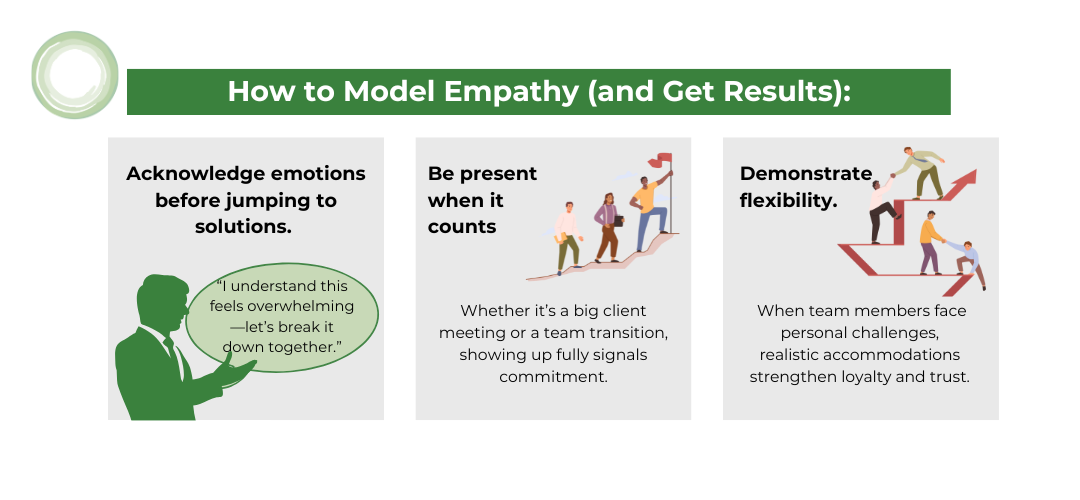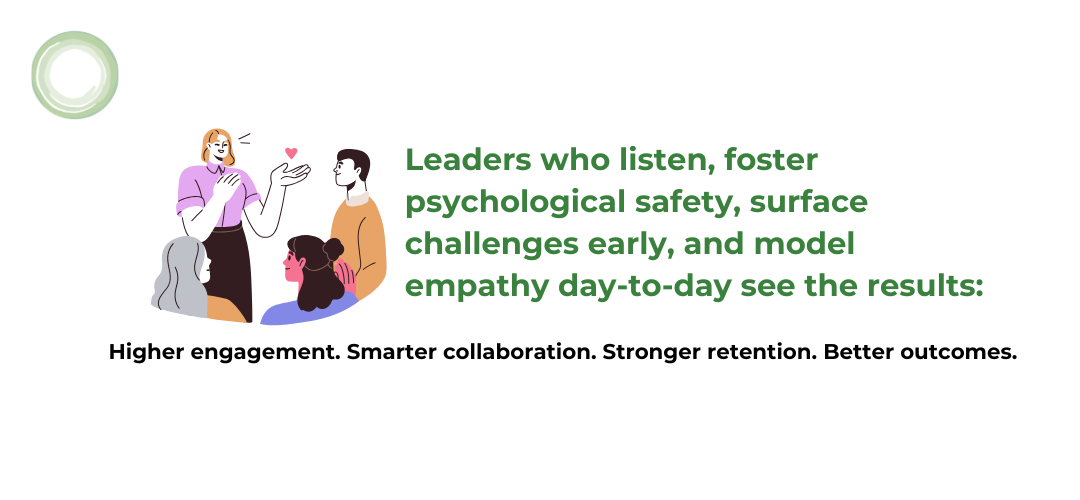4 Ways Empathy Strengthens Team Performance—Without Sacrificing Results
When the pressure’s on, most leaders default to speed and execution. But without empathy, execution falls flat.
In private equity, healthcare, and tech—whether you’re navigating a merger, staffing shortages, or market shifts—your team’s performance doesn’t hinge on efficiency alone. It hinges on whether people trust you, feel valued, and stay engaged when the stakes are high.
Empathy isn’t a soft skill. It’s a competitive edge.
It drives loyalty, sharpens collaboration, and keeps teams performing under pressure.
And it’s not innate—it’s a leadership skill you can practice and strengthen starting now.
Here’s where to start:
1. Build Trust Through Active Listening
Decision-making often gets the spotlight in fast-paced industries. But when listening takes a backseat, team members stop speaking up.
The result? Missed risks, overlooked ideas, and disengaged talent.
The leaders I coach who intentionally practice active listening flip the script. They create a culture where people feel heard—and trust leadership to lead them through complexity.
How to Make Listening Your Leadership Advantage:
- Pause before responding. Don’t rush to fill the silence. A deliberate pause signals you’re processing, not dismissing.
- Clarify and reflect. Summarize what you’ve heard: “It sounds like the timeline’s creating bottlenecks—did I get that right?”
- Ask open-ended follow-ups. Show you’re not just hearing issues; you’re solving them together.

It’s not something you leave to chance.
If you’re ready to make empathy a measurable part of how you lead, Meritage Leadership’s executive coaching programs can show you how.

When you intentionally create space to hear what’s not being said, you can course-correct before friction slows you down.
How to Surface Hidden Challenges:
- End meetings with one key question: “What’s one challenge we need to address before our next milestone?”
- Implement quarterly pulse checks. Anonymous surveys on workload balance, communication gaps, or friction points give leadership a pulse.
- Close the loop. Follow up on feedback—and outline how you’re addressing it.
A consulting firm partner I worked with was leading a high-stakes client project that was starting to show signs of strain—missed handoffs, unclear expectations, and mounting client concerns. Instead of letting issues pile up, he introduced bi-weekly check-ins specifically designed to flag miscommunications early. Each session focused on three questions: What’s working? Where are we stuck? What client concerns need immediate attention
The result? A 12% increase in client satisfaction scores. Why? Because potential breakdowns were caught—and corrected—before they impacted delivery.
4. Lead by Example: Show Empathy in Critical Moments
Your team takes its cues from how you lead under pressure.
When things don’t go as planned, do you react—or respond? Leaders who show empathy when the stakes are highest set the tone for the entire team.
How to Model Empathy (and Get Results):
- Acknowledge emotions before jumping to solutions. “I understand this feels overwhelming—let’s break it down together.”
- Be present when it counts. Whether it’s a big client meeting or a team transition, showing up fully signals commitment.
- Demonstrate flexibility. When team members face personal challenges, realistic accommodations strengthen loyalty and trust.

Example:
A senior VP at a tech company I worked with didn’t breeze past his team’s nervousness during a major restructuring. Instead, he named the tension, outlined leadership’s support, and opened up space for dialogue. That candor didn’t just ease anxiety—it strengthened team loyalty through a difficult transition.
Empathy Isn’t Optional—It’s a Leadership Advantage
Empathy is more than being approachable. It’s the skill that helps you build resilient, high-performing teams—especially when the pressure’s on.
Leaders who listen, foster psychological safety, surface challenges early, and model empathy day-to-day see the results:
Higher engagement. Smarter collaboration. Stronger retention. Better outcomes.
It’s not something you leave to chance.
If you’re ready to make empathy a measurable part of how you lead, Meritage Leadership’s executive coaching programs can show you how.



